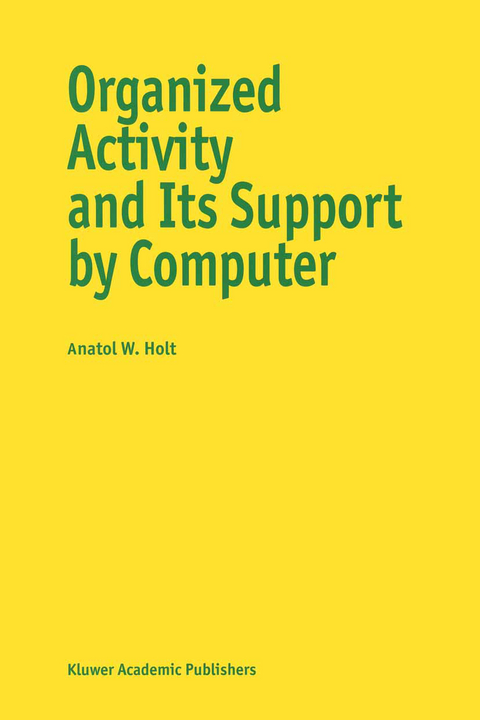
Organized Activity and its Support by Computer
Springer (Verlag)
978-94-010-6357-9 (ISBN)
With technical expertise, Anatol Holt analyzes human activity and its relevance to computer use. Holt interleaves a theory about the universal aspect of social life with a vision of how to harness computer power.
`This book is a culmination of a life of work that exemplifies two characteristics of the author: intellectual passion, and a concern for what matters to people. In the past thirty years, Holt has been a participant in the computing work at every level, from managing computer systems to developing commercial software to publishing theoretical articles in academic journals. His breadth of knowledge and experience makes possible the interweaving of theory and practice that shapes the fabric of this book. People often make a false opposition between theory and practice. In this case, it is a synergy: practice guides the theory, and the theory is grounded in its application.'
Terry Winograd, Stanford University
Organized Human Activity and Its Support by Computer will be of interest to those concerned with computers, especially those with and interest in `groupware'. Particular relevance to social scientists, management scientists, students of law, and philosophers are also addressed. Though technical in spirit and method, this book does not expect significant prior computer knowledge of the reader.
1—Introduction.- 1.1 Coordination in practice.- 1.2 Computers.- 1.3 Social machines.- 2—Preparations.- 2.1 Technical languages.- 2.2 Diagrammatic languages.- 2.3 Units.- 2.4 Units, complex units, and the Theory.- 2.5 Units and related theories.- 3—Actions, Performers.(Theory).- 3.1 Actions, performances, performers.- 3.2 Interests.- 3.3 Units for the management of failure.- 3.4 Why machines do not perform actions.- 3.5 Summary and forward pointers.- 4—Actions, Effects (Theory).- 4.1 Things (bodies), and actions.- 4.2 Types of effects.- 4.3 More on states and state changes.- 4.4 Action, solo action, and interaction.- 4.5 A brief overview of Chapters 3 and 4.- 4.6 On the vagueness of boundaries.- 5—The Pulsar (Vision).- 5.1 Getting organized activity support in focus.- 5.2 Pulsar generalities.- 5.3 Electronic meetings.- 5.4 Document production.- 5.5 Software development.- 5.6 Pulsar complexes, etc.- 5.7 The Theory so far as related to the Pulsar.- 6—Plan and Diplan (Theory).- 6.1 Plan generalities.- 6.2 Scenarios, stories, and multiplicities.- 6.3 Plans and their scenarios.- 6.4 More on plans, their scenarios, and cuts.- 6.5 The Pulsar revisited.- 7—IGO (Vision).- 7.1 Two axes of coordination.- 7.2 Material vs. activity organization.- 7.3 From a standard operating system to Igo.- 7.4 Igo and storage.- 8—Information (theory).- 8.1 Generalities.- 8.2 Preliminaries.- 8.3 Decision.- 8.4 Timing and information.- 8.5 Stepping back from the details.- 8.6 Information flow in state machines.- 9—Stores (vision).- 9.1 Generalities.- 9.2 Stores and computers.- 9.3 Databases and sharing.- 9.4 Some (surprising) relationships to the Theory.- 10—The Vision as a Whole.- 10.1 From a standard operating system to Igo.- 10.2 Centropolies and Igos: a new e-world.- 10.3World-wide coordination.- 11—The Theory as a Whole.- 11.1 The Theory and science in general.- 11.2 Pure vs. applied.- 11.3 “Science”about human behavior.- 11.4 “Pre-mathematical”?.- 11.5 State and prospects.- APPENDIX A: Information, and state machine structure.- APPENDIX B: Petri nets, and related Diplan exercises.- Cumulative bibliography.- Analytical index.
| Zusatzinfo | XII, 198 p. |
|---|---|
| Verlagsort | Dordrecht |
| Sprache | englisch |
| Maße | 160 x 240 mm |
| Themenwelt | Mathematik / Informatik ► Informatik ► Betriebssysteme / Server |
| Informatik ► Software Entwicklung ► User Interfaces (HCI) | |
| Mathematik / Informatik ► Informatik ► Theorie / Studium | |
| Mathematik / Informatik ► Mathematik | |
| Sozialwissenschaften ► Soziologie | |
| ISBN-10 | 94-010-6357-5 / 9401063575 |
| ISBN-13 | 978-94-010-6357-9 / 9789401063579 |
| Zustand | Neuware |
| Haben Sie eine Frage zum Produkt? |
aus dem Bereich


